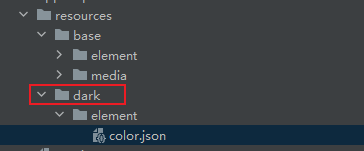harmony 鸿蒙Dark and Light Mode Adaptation
Dark and Light Mode Adaptation
Overview
To enhance user experience, applications should adapt to the system’s dark and light modes. There are two primary scenarios for implementing this adaptation:
Following the System’s Color Mode
Setting the Application’s Color Mode Independently
Following the System’s Color Mode
Color Adaptation
- Custom Resource Implementation
Create a dark folder under the resources directory and add a color.json file to define dark mode color resources. For details, see Resource Categories and Access.
Figure 1 Structure of the resources directory

The following is the example configuration:
base/element/color.json file:
{ "color": [ { "name": "app_title_color", "value": "#000000" } ] }dark/element/color.json file:
{ "color": [ { "name": "app_title_color", "value": "#FFFFFF" } ] }- System Resource Implementation
You can use system-provided resources, which automatically adapt to different configurations including the device type and dark or light mode. The same resource ID can have different values under these configurations. This means you don’t need to create separate color resources for dark and light modes. Instead, you can reference system resources to maintain a consistent look. For example, to set your application’s text color, simply use:
Text('Use system-defined colors') .fontColor($r('sys.color.ohos_id_color_text_primary'))Image Resource Adaptation
To adapt images to dark and light modes, use resource qualifier directories. Specifically, place images with the same name in the dark/media directory. Reference these images using the $r syntax based on their key values. The system will automatically load the appropriate image based on the current mode.
For SVG icons, use the fillColor attribute with system resources to dynamically adjust their appearance for dark and light modes, eliminating the need for separate image sets.
Image($r('app.media.pic_svg')) .width(50) .fillColor($r('sys.color.ohos_id_color_text_primary'))Web Component Adaptation
The Web component supports dark color mode configuration. For details, see Setting the Dark Mode.
Listening for Color Mode Switching Events
Applications can listen for system color mode changes and perform custom logic, such as initializing resources of other types. This approach works regardless of whether the application is set to follow the system’s dark or light mode.
a. Save the current color mode to the AppStorage in the onCreate() lifecycle of the AbilityStage.
onCreate(): void { hilog.info(0x0000, 'testTag', '%{public}s', 'Ability onCreate'); AppStorage.setOrCreate('currentColorMode', this.context.config.colorMode); }b. Update the color mode to the AppStorage in the onConfigurationUpdate() lifecycle callback of the AbilityStage..
onConfigurationUpdate(newConfig: Configuration): void { AppStorage.setOrCreate('currentColorMode', newConfig.colorMode); hilog.info(0x0000, 'testTag', 'the newConfig.colorMode is %{public}s', JSON.stringify(AppStorage.get('currentColorMode')) ?? ''); }c. Use @StorageProp and @Watch to listen for color mode changes and refresh the state variable.
@StorageProp('currentColorMode') @Watch('onColorModeChange') currentMode: number = ConfigurationConstant.ColorMode.COLOR_MODE_LIGHT;d. Refresh the state variable based on the latest color mode in the aboutToAppear() API.
aboutToAppear(): void { if (this.currentMode == ConfigurationConstant.ColorMode.COLOR_MODE_LIGHT) { // Light mode initialization logic }else { // Dark mode initialization logic } }e. Implement the same logic in the @Watch callback function.
onColorModeChange(): void { if (this.currentMode == ConfigurationConstant.ColorMode.COLOR_MODE_LIGHT) { // Light mode initialization logic } else { // Dark mode initialization logic } }
Setting the Application’s Color Mode Independently
By default, applications follow the system’s color mode. Yet, you can set a fixed mode for your application regardless of the system settings.
onCreate(): void {
hilog.info(0x0000, 'testTag', '%{public}s', 'Ability onCreate');
this.context.getApplicationContext().setColorMode(ConfigurationConstant.ColorMode.COLOR_MODE_DARK);
}
Default Judgment Rule
If the application calls the setColorMode API, its effect takes precedence.
If the application does not call the setColorMode API:
When the application has dark resources in the dark directory, built-in components automatically switch to dark mode.
When no dark resources are available, built-in components remain in light mode.

If your application uses built-in components or colors and you want it to switch between dark and light modes along with the system, modify the code as follows to ensure a consistent user experience:
onCreate(): void {
this.context.getApplicationContext().setColorMode(ConfigurationConstant.ColorMode.COLOR_MODE_NOT_SET);
}
你可能感兴趣的鸿蒙文章
harmony 鸿蒙Atomic Service Full Screen Launch Component (FullScreenLaunchComponent)
harmony 鸿蒙Arc Button (ArcButton)
harmony 鸿蒙Frame Animation (ohos.animator)
harmony 鸿蒙Implementing Property Animation
- 所属分类: 后端技术
- 本文标签:
热门推荐
-
2、 - 优质文章
-
3、 gate.io
-
7、 openharmony
-
9、 golang